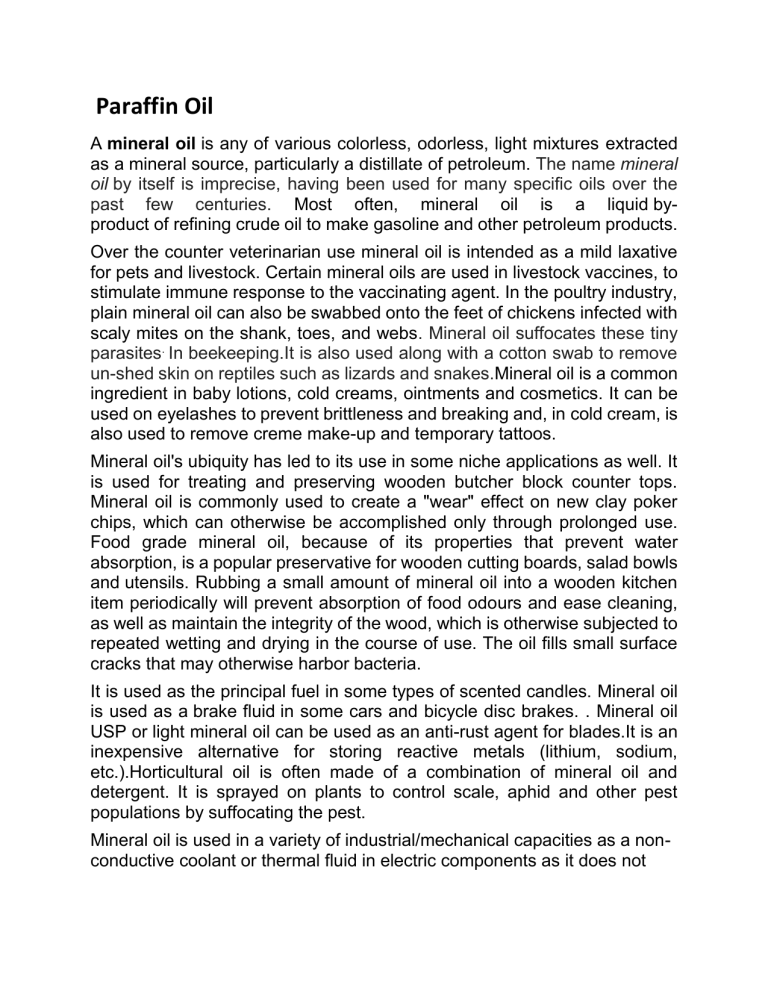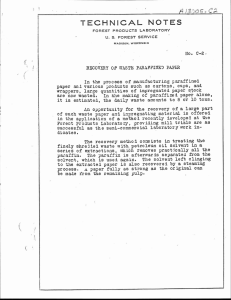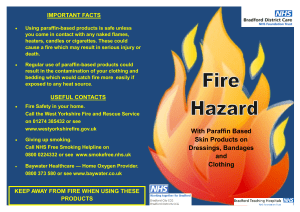
Paraffin Oil A mineral oil is any of various colorless, odorless, light mixtures extracted as a mineral source, particularly a distillate of petroleum. The name mineral oil by itself is imprecise, having been used for many specific oils over the past few centuries. Most often, mineral oil is a liquid byproduct of refining crude oil to make gasoline and other petroleum products. Over the counter veterinarian use mineral oil is intended as a mild laxative for pets and livestock. Certain mineral oils are used in livestock vaccines, to stimulate immune response to the vaccinating agent. In the poultry industry, plain mineral oil can also be swabbed onto the feet of chickens infected with scaly mites on the shank, toes, and webs. Mineral oil suffocates these tiny parasites. In beekeeping.It is also used along with a cotton swab to remove un-shed skin on reptiles such as lizards and snakes.Mineral oil is a common ingredient in baby lotions, cold creams, ointments and cosmetics. It can be used on eyelashes to prevent brittleness and breaking and, in cold cream, is also used to remove creme make-up and temporary tattoos. Mineral oil's ubiquity has led to its use in some niche applications as well. It is used for treating and preserving wooden butcher block counter tops. Mineral oil is commonly used to create a "wear" effect on new clay poker chips, which can otherwise be accomplished only through prolonged use. Food grade mineral oil, because of its properties that prevent water absorption, is a popular preservative for wooden cutting boards, salad bowls and utensils. Rubbing a small amount of mineral oil into a wooden kitchen item periodically will prevent absorption of food odours and ease cleaning, as well as maintain the integrity of the wood, which is otherwise subjected to repeated wetting and drying in the course of use. The oil fills small surface cracks that may otherwise harbor bacteria. It is used as the principal fuel in some types of scented candles. Mineral oil is used as a brake fluid in some cars and bicycle disc brakes. . Mineral oil USP or light mineral oil can be used as an anti-rust agent for blades.It is an inexpensive alternative for storing reactive metals (lithium, sodium, etc.).Horticultural oil is often made of a combination of mineral oil and detergent. It is sprayed on plants to control scale, aphid and other pest populations by suffocating the pest. Mineral oil is used in a variety of industrial/mechanical capacities as a nonconductive coolant or thermal fluid in electric components as it does not conduct electricity, while simultaneously functioning to displace air and water. Oil is money," "And money tends to be power, and the problem with oil, and the money and the power that it generates is that it’s incredibly concentrated. So it’s in a few places in very large quantities, and it leads to a struggle because the stakes are so high. And the problem is -- and this is the paradox really -- is that people who live on top of the oil, for example, in Nigeria ... people actually live on top of the oil, they don’t benefit from it; and in fact, in places like that they suffer because of it. In fact, in Nigeria, not only do you have a tremendous amount of pollution, but you also have a tremendous amount of violence, and you have a tremendous amount of poverty. And it’s not despite the oil, but because of the oil. On the other hand, Paraffin oil, known as kerosene in Australia and the United States and stove oil in Canada, is an flammable liquid hydrocarbon burned as fuel. It is most commonly used to power jet engines for aircraft, but can also be used for heating, lighting, and cooking. It is refined from petroleum and is relatively cheap to produce. It is still used to some extent for portable lamps and stoves, most often by campers or in developing countries. This oil is most often used in the modern world as fuel for jet planes and rockets. Paraffin oil has also been used as an industrial solvent and lubricant. It can be used to store substances that may be damaged by or volatile in the presence of oxygen. Mechanical, electrical and industrial An electrical heat radiator that uses mineral oil as a heat transfer fluid Electric space heaters sometimes use mineral oil as a heat transfer oil. Because it is noncompressible, mineral oil is used as a hydraulic fluid in hydraulic machinery and vehicles. It is also used as a lubricant and a cutting fluid. Light mineral oil is also used in textile industries and used as a jute batching oil. An often cited limitation of mineral oil is that it is poorly biodegradable; in some applications, vegetable oils such as cottonseed oil or rapeseed oil may be used instead. The Paraffin Oil has (in my opinion) three benefits: 1. It greatly simplifies the polishing as it does not evaporate during the procedure. 2. It appears to produce a .. Opinions Despite, Paraffin oil has an alluring smell for many, it is very difficult to judge its implications rightly. millions to use it as an age defying substance Many believe that paraffin oil when taken as a fuel shapes the destiny of countries providing them charming opportunities to excel in their future progression. power and its charming possession brings immense joy to people who hold it. What is Paraffin Wax? Paraffin wax is a more subtle form of medical paraffin available and is mainly used in depilatory procedures. It is derived from petroleum and has a low melting point, making it perfect for skin application. Cosmetologists also use it to create a paraffin wax bath that has various skin benefits. Eye Lubrication Due to its lubrication properties, liquid paraffin can be used to relieve some cases of moderate dry eyes. Dry eye occurs when there is no sufficient quality tear to nourish and lubricate the eye. Special paraffin designed for eye lubrication can be applied to correct such eye defects and also encourage the production of natural tears. It is however important to use paraffin eye lubrication only when advised by your doctor. In Cosmetic Products Paraffin is a common ingredient in most cosmetic products, ranging from detergent creams to hydrated creams, cold creams, makeup oils, and bronze oils among others. Paraffin wax is also used in beauty products and emollients. Because of its viscosity, cosmetologists may recommend paraffin wax to those who want to remove hair from their arms, legs, chest, bikini lines, and eyebrows. Wax has a long history of use in the cosmetic world and can be traced back to Roman Empire massages and physical therapies. Today, paraffin wax is available for a host of skin benefits, in addition to softening and smoothing. Parents can apply paraffin wax on their babies to reduce the risk of skin rashes and eczema caused when babies remain napped for several hours. There are other medically approved uses of paraffin and doctors can suggest its use at any time for a variety of digestive and skin ailments. Some physicians have even recommended paraffin treatments to arthritis and fibromyalgia patients. Benefits of Using Paraffin The advantages of using paraffin are quite obvious and straightforward. From maintaining soft, smooth skin to treating dry palms, paraffin is more than just an additive used in salons and spas. Some of the clear cut benefits of using paraffin include the following: Cosmetic Benefits Most salons and health spas use paraffin in various treatments for the skin and body. It opens pores and exfoliates dead skin cells, exposing new rejuvenated skin. It also provides a barrier that locks in all the natural oils your body provides. Additionally, paraffin increases moisture and can help you soften calluses and dry hands. This is why it is a recognized emollient approved by the Food and Drug Administration. Therapeutic Benefits Besides cosmetic benefits, paraffin treatment can result in therapeutic benefits and has been recommended in the management of arthritis and fibromyalgia. When used in massage, paraffin wax quickly builds up heat resulting in thermo-therapy that relaxes stiff muscles, increases blood flow, and soothes joint pain. It also reduces spasms in sprained and pulled muscles. Cost and Safety Benefits Paraffin treatment is cheaper and safer than most alternatives. In fact, they are some of the cheapest cosmetic and therapeutic products in the market. What’s more, the treatment is noninvasive. Risks and Side Effects Since paraffin is natural and safe, no side effects have been identified. However, it is advisable to avoid external paraffin treatment if you have numbness in the hands and/or feet, if you have poor blood circulation, or if you have open sores, rashes, and wounds. Diabetics should also stay away from paraffin treatment. Finding liquid paraffin listed as one of the ingredients in a cream or lotion can be confusing for some consumers. After all, paraffin is a term that’s commonly associated with candles, which don’t really have anything to do with skin care. But a deeper look at liquid paraffin will reveal that this common personal care ingredient is used in many skin products, including creams, lotions, lip balm, soap, and even eczema ointments. But what does liquid paraffin do, and more importantly, is it safe to use on the skin? To better understand this ingredient, let’s take a deeper look at its role in skin care and the possible side effects it can induce. What is Liquid Paraffin? How is Liquid Paraffin Used? Possible Dangers of Liquid Paraffin One of the criticisms of liquid paraffin is that it doesn’t actually moisturize the skin. It’s certainly important to reinforce the skin’s natural moisture barrier, but many skin care experts suggest that the feeling of moisture isn’t real. After someone uses a cream with liquid paraffin, the soft, silky sensation on the skin is that of mineral oil on the surface, and not of the actual skin texture. The skin is simply covered with something that feels soft! Therefore, some argue that the moisturizing effects of liquid paraffin are simply a sensory illusion! For example, another way to achieve a sensation of soft skin is to grab a little bit of baking soda, mix it with water to create a paste, and then rub the hands together with the rough particles scrubbing against the skin. After the paste is washed off, the hands will feel incredibly soft to the touch. After a few hours, however, this sensation fades. The reason behind this is the temporary sensation created at the tips of the fingers by the rubbing of rough particles – everything else starts to feel comparatively soft! But just because the skin feels softer, that doesn’t mean it actually IS softer. The same argument can be made for liquid paraffin. The bigger danger, however, is that liquid paraffin may cause breakouts in some individuals. For example, some skin experts suggest that this ingredient can clog pores and promote the development of comedonal acne. Although the research on this topic is still inconclusive, individuals with a history of severe acne may want to avoid products with liquid paraffin, as a safety precaution. Products with Liquid Paraffin There are many products on the market that contain liquid paraffin, including diaper cream, foot moisturizer, and cosmetics, among others. Because of the widespread use of this chemical, those concerned with possible side effects should carefully inspect product labels of all skin care products before purchase, and to look for the alternate name “mineral oil” as well. To avoid serious side effects from liquid paraffin, it’s a good idea to discuss this ingredient in detail with a dermatologist. Mineral oil in drugs and cosmetics Other uses of mineral oil with its side effects Two opinions True false


